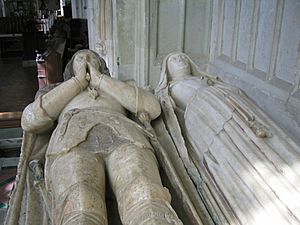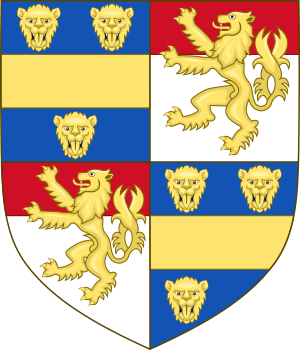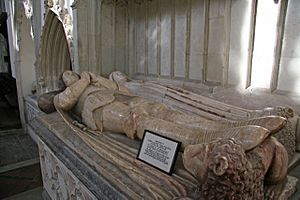John de la Pole, 2nd Duke of Suffolk facts for kids
Quick facts for kids John de la Pole |
|
|---|---|
| Duke of Suffolk | |

Effigies of John de la Pole, 2nd Duke of Suffolk, KG, and his wife, in Wingfield Church, Suffolk. He wears the Garter below his left knee
|
|
| Duke of Suffolk | |
| Title held | 1463–1492 |
| Born | 27 September 1442 |
| Died | 14-21 May 1492 (aged 49) |
| Burial | Wingfield, Suffolk |
| Spouse | Lady Margaret Beaufort (1450–1453; annulled) Elizabeth of York (1458–1492; his death) |
| Issue more... |
John de la Pole, 1st Earl of Lincoln Edmund de la Pole, 3rd Duke of Suffolk William de la Pole Richard de la Pole |
| Father | William de la Pole, 1st Duke of Suffolk |
| Mother | Alice Chaucer |
| Religion | Roman Catholicism |
John de la Pole, 2nd Duke of Suffolk, a Knight of the Order of the Garter, was an important noble in 15th-century England. He was born on September 27, 1442, and died between May 14 and 21, 1492. John was the son of William de la Pole, 1st Duke of Suffolk, and Alice Chaucer, who was the granddaughter of the famous poet Geoffrey Chaucer.
John's early life was difficult because his father, a close friend of King Henry VI, lost his power and was murdered in 1450. Although his father had become very rich, John inherited the title of Duke of Suffolk in 1463 as one of the poorest dukes in England. He often felt too poor to travel to London and keep up with other nobles.
As a young man, John de la Pole married twice. His first marriage was ended, but his second marriage to Elizabeth of York made him the brother-in-law of two kings: Edward IV and Richard III. John and Elizabeth had eleven children. Their oldest son, John, was even named the heir to King Richard III in 1484.
John de la Pole usually tried to stay out of the major conflicts of the Wars of the Roses. Even though his marriage connected him to the House of York, he didn't fight in battles until Edward IV became king. Instead, he spent a lot of time arguing with his neighbors in East Anglia, the Paston family, over land.
Contents
Early Life and Family Connections
John de la Pole was born on September 27, 1442. He was the only son of William de la Pole, 1st Duke of Suffolk, and Alice Chaucer. When John was just seven years old, he married six-year-old Lady Margaret Beaufort in 1450. This marriage was later ended in 1453.
John's father, William, was a very important advisor to King Henry VI. He became an Earl, then a Marquess, and finally a Duke. With these titles, he received many gifts of land and money from the King. John's mother, Alice, also owned a lot of land from her own family and previous marriages.
His Father's Downfall
In 1450, John's father faced serious problems. He was accused by Parliament of causing England to lose land in Normandy during the Hundred Years' War. His father was sent away from England, but he was killed by sailors before he could leave the country.
Because his father was not officially found guilty, John still inherited the title of Duke of Suffolk. However, the King took back many of the lands and jobs that John's father had received. This meant John had much less money and power than his father. His income was very low, much less than what was expected for a Duke.
John was still a child when his father died. The King took control of John's lands until he became an adult in 1463.
Starting His Career
John de la Pole began to take on official duties around 1457, when he was about 15 years old. Around 1458, his mother arranged for him to marry Elizabeth of York. Elizabeth was the daughter of Richard, Duke of York. This marriage happened during a very unstable time in English politics.
A Royal Marriage
John's marriage to Elizabeth was important because it connected him to the powerful House of York. Elizabeth brought some money with her, but it wasn't a huge amount, and her father often had trouble paying it.
Local Issues and Disputes
Much of John's early work in East Anglia was probably guided by his mother, Alice. He often served as a justice of the peace in Norfolk and Suffolk, helping to keep order. He even tried to influence local Parliamentary elections and the choice of the county sheriff.
John became involved in some big arguments over land. For example, he tried to buy part of the Fastolf family's inheritance in 1461. This led to a major feud with the Paston family, who also wanted parts of the inheritance. John and his mother were both deeply involved in these disputes.
In 1465, some of John's followers even destroyed a manor house and ransacked a church in Norfolk. John usually avoided punishment for these actions, likely because of his connections to the royal family. However, he couldn't always get the King to help him win his land disputes.
The Wars of the Roses
John's marriage to Elizabeth of York connected him to the Yorkist side in the Wars of the Roses. This was a series of civil wars fought between the House of Lancaster (who supported King Henry VI) and the House of York.
In 1459, John's father-in-law, Richard of York, and his brother-in-law, Edward, were forced to leave England. John himself did not take part in their military campaigns at this time.
In 1460, some people claimed that John lost his title as Duke and was made only an Earl because he married York's daughter. However, official records still called him a Duke.
By early 1461, John had clearly chosen to support the Yorkist side. He fought alongside Richard, Earl of Warwick, at the Second Battle of St Albans in February 1461. He also fought at the Battle of Towton in March, which was a huge victory for the Yorkists. After this victory, John's cousin and brother-in-law, Edward, became King Edward IV of England. John served as a Lord Steward at Edward's coronation.
Later Years and Royal Service
Serving King Edward IV
Under the new King Edward IV, John de la Pole joined the King's campaign against the Scots in 1462. His title as Duke of Suffolk was officially confirmed by King Edward in 1463. He also received an annual payment from the King, though it was tied to his wife's life. In 1467, his oldest son, John, was made Earl of Lincoln.
Even though John didn't get a lot of money from the new King, he took part in many important state events. These included royal weddings and tournaments. As King Edward's relationship with the powerful Earl of Warwick worsened, John remained loyal to his brother-in-law. He helped the King put down the 1470 Lincolnshire Rebellion in 1470.
When King Edward was forced to leave England later that year, John de la Pole was not trusted by the new Lancastrian government. However, when Edward IV returned to England in 1471, John joined him. He fought in the battles of Barnet and Tewkesbury, where the Yorkists finally defeated the Lancastrian army.
After these victories, John received some new positions, but they didn't make him rich. In fact, his financial situation was still so bad that in 1471, he refused to attend Parliament. He felt he couldn't afford to keep up the appearance of a royal duke in London. In 1475, he joined King Edward's campaign in France, but he could only bring a small group of soldiers.
Soon after returning from France, his mother, Alice, died in 1476. This meant John finally gained full control of all his family's lands.
Under Richard III and Henry VII
King Edward IV died suddenly in 1483. John de la Pole was present when Edward's brother, Richard, Duke of Gloucester, claimed the throne. John even carried the royal sceptre at Richard's coronation. John's son, the Earl of Lincoln, may have been named Richard III's heir to the throne after Richard's own son died.
In 1485, Henry Tudor invaded England. John de la Pole did not fight at the Battle of Bosworth Field, where Richard III was defeated and killed. However, his son, Lincoln, did fight for King Richard. Despite this, the new King Henry VII did not punish John de la Pole. John even got back some of his old positions.
In 1487, John's son, Lincoln, took part in a rebellion against King Henry VII and was killed in the Battle of Stoke Field. Even though his son rebelled, John de la Pole still kept the King's trust. He continued to serve as a justice of the peace and helped gather soldiers for the King.
Final Years and Legacy
John de la Pole died in 1492. He was buried in the church at Wingfield in Suffolk, where he had founded a college. His tomb is very grand, showing him wearing the special robe of the Order of the Garter. His head rests on a helmet with the de la Pole family crest: a Saracen's head. His wife, Elizabeth, was later buried next to him.
His Tomb
John de la Pole's tomb at Wingfield church shows him as a Duke wearing his coronet. Historians have noted that his tomb shows how important nobles wanted to appear, even in death. The tomb also has beautiful details of the Order of the Garter that he wore. It is considered a wonderful example of a knight's tomb from the 15th century.
Children
John de la Pole and Elizabeth of York had eleven known children:
- John, Earl of Lincoln (born around 1462, died 1487) was their oldest son. He became the heir to King Richard III. After Richard's death, John rebelled against King Henry VII and was killed in battle.
- Geoffrey (born around 1464) died when he was young.
- Edward (1466–1485) joined the church and became an Archdeacon.
- Elizabeth (born around 1468, died 1489) married Henry Lovel, 8th Baron Morley. They had no children.
- Edmund (1471–1513) eventually became the next Duke of Suffolk. He later became a rival to King Henry VIII and was executed.
- Dorothy (born 1472) died when she was young.
- Humphrey (1474–1513) became a priest.
- Anne (1476–1495) became a nun.
- Katherine (born around 1477, died 1513) married William Stourton, 5th Baron Stourton. They had no children.
- Sir William de la Pole (1478–1539)
- Richard de la Pole (1480–1525)
John de la Pole's two youngest sons, William and Richard, were involved in a plot against King Henry VII in 1501. Sir William was imprisoned in the Tower of London for 37 years. Richard escaped to France and fought in wars there. He was killed in battle in 1525.
Images for kids
-
Church of St Mary the Virgin, Iffley, Oxfordshire, 15th-century stained glass of the arms of John de la Pole, 2nd Duke of Suffolk.





